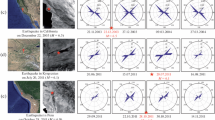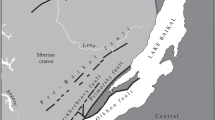Abstract
We present the results of studying anomalous variations in the lineament system during the preparation to the M = 5.6 earthquake that occurred on September 21, 2020, near Lake Baikal, 21 km from the settlement of Kultuk, at a depth of 10 km. The study method, based on the automated lineament analysis of satellite imagery, is described. Peculiarities of the Baikal rift zone structure and its seismic activity are analyzed. Schemes of hatch elongation lines, schemes of regional lineaments, and rose diagrams of lineaments are constructed on the basis of processed series of satellite imagery obtained by Terra (MODIS) in the period from May 25 to October 6, 2020. The total lengths of local lineaments and ratios of their lengths for various directions are calculated. All the data have allowed us to reveal anomalous variations in lineament systems 14 and 5 days before the earthquake of September 21, 2020. It is concluded that these anomalies are geodynamic precursors of the mentioned earthquake.





Similar content being viewed by others

REFERENCES
Aerokosmicheskie metody geologicheskikh issledovanii (Aerospace Methods for Geological Investigations), Pertsov, A.V., Ed., St/ Petersburg, VSEGEI, 2000.
Akopian, S.Ts., Bondur, V.G., and Rogozhin, E.A., Technology for monitoring and forecasting strong earthquakes in Russia with the use of the seismic entropy method, Izv., Phys. Solid Earth, 2017, vol. 53, no. 1, pp. 32–51. https://doi.org/10.1134/S1069351317010025
Aktual’nye voprosy sovremennoi geodinamiki Tsentral’noi Azii (Important Issues of Current Geodynamics of Central Asia), Novosibirsk: Izd. SO RAN, 2005.
Baikal: priroda i lyudi: entsiklopedicheskii spravochnik (Baikal: The Nature and People: Encyclopedic Dictionary), Tulokhonov, A.K., Ed., Ulan-Ude: EKOS, 2009.
Boikov, A.M. and Kornienko, S.G., Manifestation of seismogenic lineaments of Dagestan in space thermal imagery data: Theory and experiment, Tr. Inst. Geol. Dagest. Nauchn. Tsentra Ross. Akad. Nauk, 2007, no. 51, pp. 68–76.
Bondur, V.G., Modern approaches to processing large hyperspectral and multispectral aerospace data flows, Izv., Atmos. Ocean. Phys., 2014, vol. 50, no. 9, 840–852.
Bondur, V.G. and Kuznetsova, L., Satellite monitoring of seismic hazard area geodynamics using the method of lineament analysis, in 31st International Symposium on Remote Sensing of Environment (ISRSE), St. Petersburg, 2005, pp. 376–379.
Bondur, V.G. and Smirnov, V.M., Method for monitoring seismically hazardous territories by ionospheric variations recorded by satellite navigation systems, Dokl. Earth Sci., 2005, vol. 403, no. 5, pp. 736–740.
Bondur, V.G. and Voronova, O.S., Variations in outgoing longwave radiation during the preparation and occurrence of strong earthquakes in Russia in 2008 and 2009, Izv. Vyssh. Uchebn. Zaved., Geod. Aerofotos’emka, 2012, no. 1, pp. 79–85.
Bondur, V.G. and Zverev, A.T., A method of earthquake forecast based on the lineament analysis of satellite images, Dokl. Earth Sci., 2005a, vol. 402, no. 4, pp. 561–567.
Bondur, V.G. and Zverev, A.T., A method of earthquake forecast based on the lineament dynamic analysis using satellite imagery, Issled. Zemli Kosmosa, 2005b, no. 3, pp. 37–52.
Bondur, V.G. and Zverev, A.T., Lineament system formation mechanisms registered in space images during the monitoring of seismic danger areas, Issled. Zemli Kosmosa, 2007, no. 1, pp. 47–56.
Bondur, V.G., Garagash, I.A., Gokhberg, M.B., Lapshin, V.M., Nechaev, Yu.V., Steblov, G.M., and Shalimov, S.L., Geomechanical models and ionospheric variations related to strongest earthquakes and weak influence of atmospheric pressure gradients, Dokl. Earth. Sci., 2007, vol. 414, no. 1, pp. 666–669.
Bondur, V.G., Krapivin, V.F., and Savinykh, V.P., Monitoring i prognozirovanie prirodnykh katastrof (Monitoring and Forecast of Natural Catastrophes), Moscow: Nauchnyi mir, 2009.
Bondur, V.G., Garagash, I.A., Gokhberg, M.B., Lapshin, V.M., and Nechaev, Yu.V., Connection between variations of the stress-strain state of the Earth’s crust and seismic activity: The example of Southern California, Dokl. Earth. Sci., 2010, vol. 430, no. 3, pp. 147–150.
Bondur, V.G., Garagash, I.A., Gokhberg, M.B., and Rodkin, M.V., The evolution of the stress state in Southern California based on the geomechanical model and current seismicity, Izv., Phys. Solid Earth, 2016, vol. 52, no. 1, pp. 117–128. https://doi.org/10.1134/S1069351316010043
Bondur, V.G., Tsidilina, M.N., Gaponova, E.V., and Voronova, O.S., Systematization of ionospheric, geodynamic, and thermal precursors of strong (M ≥ 6) earthquakes detected from space, Izv., Atmos. Ocean. Phys., 2018, vol. 54, no. 9, pp. 1392–1405. https://doi.org/10.1134/S0001433818090475
Bondur, V.G., Zverev, A.T., and Gaponova, E., Precursor variability of lineament systems detected using satellite images during strong earthquakes. Izv., Atmos. Ocean. Phys., 2019, vol. 55, no. 9, pp. 1283–1291.
Bondur, V.G., Tsidilina, M.N., Gaponova, E.V., and Voronova, O.S., Joint analysis of anomalies of different geophysical fields, recorded from space before strong earthquakes in California, Izv., Atmos. Ocean. Phys., 2020a, vol. 56, no. 9, pp. 1502–1519. https://doi.org/10.1134/S000143382012035X
Bondur, V.G., Gokhberg, M.B., Garagash, I.A., and Alekseev, D.A., Revealing short-term precursors of the strong M > 7 earthquakes in Southern California from the simulated stress-strain state patterns exploiting geomechanical model and seismic catalog data, Frontiers Earth Sci., 2020b, vol. 8, id 571700. https://doi.org/10.3389/feart.2020.571700
Bondur, V.G., Chimitdorzhiev, T.N., Tubanov, Ts.A., Dmitriev, A.V., and Dagurov, P.N., Analysis of the block-fault structure dynamics in the area of earthquakes in 2008 and 2020 near southern Lake Baikal by the methods of satellite radiointerferometry, Dokl. Earth Sci., 2021, vol. 499, no. 2, pp. 648–653.
Gaponova, E.V., Zverev, A.T., and Tsidilina, M.N., Detecting lineament system anomalies during strong 6.4 and 7.1 earthquakes in California from satellite imagery, Izv., Atmos. Ocean. Phys., 2020, vol. 56, no. 9, pp. 1062–1071.
Ivanchenko, G.N. and Gorbunova, E.M., Ispolzovaniye dannykh distantsionnogo zondirovaniya uchastkov zemnoy kory dlya analiza geodinamicheskoy obstanovki (The Use of Data from Remote Sensing of the Earth’s Crust for the Analysis of Geodynamic Conditions), Moscow: GEOS, 2015.
Kats, Ya.G., Poletaev, A.I., and Rumyantseva, E.F., Osnovy lineamentnoi tektoniki (Fundamentals of Lineament Tectonics), Moscow: Nedra, 1986.
Keilis-Borok, V., Gabrielov, A., and Soloviev, A., Geo-complexity and earthquake prediction, in Encyclopedia of Complexity and Systems Science, Meyers, R., Ed., New York: Springer, 2009, pp. 4178–4194.
Kissin, I.G., On the system approach in the problem of forecasting the earthquakes, Izv., Phys. Solid Earth, 2013, vol. 49, no. 4, pp. 587–600. https://doi.org/10.1134/S1069351313040058
Korchuganova, N.I. and Korsakov, A.K., Distantsionnye metody geologicheskogo kartirovaniya: uchebnik (Remote Methods of Geological Mapping: A Textbook), Moscow: KDU, 2009.
Lunina, O.V., Gladkov, A.S., and Sherman, S.I., Variations of stress fields in the Tunka rift of the southwestern Baikal region, Geotectonics, 2007, vol. 41, no. 3, pp. 231–256.
Mats, V.D., Granina, L.Z., and Efimova, I.M., The Baikal rift: Towards the ocean, Priroda, 2014, no. 2, pp. 28–38.
Mogi, K., Earthquake Prediction, Tokyo: Academic, 1985; Moscow: Mir, 1988.
Ouzounov, D., Liu, D., Kang, C., Cervone, G., Kafatos, M., and Taylor, P., Outgoing long wave radiation variability from IR satellite data prior to major earthquakes, Tectonophysics, 2007, vol. 431, pp. 211–220.
Pulinets, S.A., Bondur, V.G., Tsidilina, M.N., and Gaponova, M.V., Verification of the concept of seismoionospheric coupling under quiet heliogeomagnetic conditions, using the Wenchuan (China) earthquake of May 12, 2008, as an example, Geomagn. Aeron. (Engl. Transl.), 2010, vol. 50, no. 2, pp. 231–242.
Sobolev, G.A. and Ponomarev, A.V., Fizika zemletryasenii i predvestniki (Earthquake Physics and Precursors), Moscow: Nauka, 2003.
Tronin, A.A., Satellite remote sensing in seismology: A review, Remote Sens., 2010, vol. 2, no. 1, pp. 124–150.
Vilor, N.V., Adrulaitius, L.D., Zarubina, O.V., and Danilov, B.S., Geochemistry of seismoactive regional faults: Baikal Rift zone, Eastern Siberia, Geochem. Int., 2015, vol. 53, no. 1, pp. 60–77.
Zlatopolsky, A., Program LESSA (Lineament Extraction and Stripe Statistical Analysis) automated linear image features analysis: Experimental results, Comput. Geosci., 1992, vol. 18, no. 9, pp. 1121–1126.
Zlatopolsky, A., Description of texture orientation in remote sensing data using computer program LESSA, Comput. Geosci., 1997, vol. 23, no. 1, pp. 45–62.
Zlatopolsky, A.A., Technique for measuring orientation characteristics of remote sensing data (LESSA technology), Sovrem. Probl. Distantsionnogo Zondirovaniya Zemli Kosmosa, 2008, vol. 1, no. 5, pp. 102–112.
Funding
This study was performed in ISR “AEROCOSMOS” in the framework of the project no. AAAA-A19-119081390037-2.
Author information
Authors and Affiliations
Corresponding author
Ethics declarations
The authors declare that they have no conflicts of interest.
Additional information
Translated by N. Astafiev
Rights and permissions
About this article
Cite this article
Bondur, V.G., Gaponova, E.V. Remotely Registering Anomalous Variations in Lineament Systems of the Baikal Rift Zone during the M = 5.6 Earthquake of September 21, 2020. Izv. Atmos. Ocean. Phys. 57, 1012–1020 (2021). https://doi.org/10.1134/S0001433821090437
Received:
Revised:
Accepted:
Published:
Issue Date:
DOI: https://doi.org/10.1134/S0001433821090437



